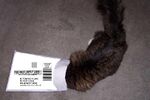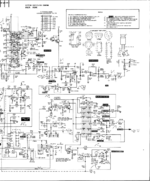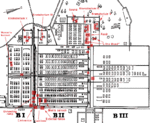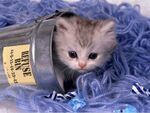Kitten recycling center
The first kitten recycling center was founded in 1932 as an experiment by Professor Frink. While toiling in his laboratory (pronounced in 1932 as 'luh-BORE-uh-tory') the mighty professor discovered something he had only read about in the dictionary: kittens were crafted entirely out of recyclable materials such as wood, cheddar, meat and iron. Through rigorous experiments spanning nearly an entire day, the great professor deduced that cats, unlike kittens in virtually every possible way, were made out of entirely unrecyclable materials. This puzzled the professor. But after a brief nap, he shook off his puzzlement, and continued with his research.
The professor only had a small homemade batch of 59 kittens to work with. His experiments would have to be chosen wisely. He knew determining the swiftest way to recycle kittens was of utmost importance. This would, according to Norway, lead to the emergence and eventual dominance of the Kitten recycling market. Through trial and error, the professor deduced two main facts:
- Kittens could travel over 4 km with the appropriate trebuchet
- Kittens possessed no soul and were capable of severe bodily harm when squeezed
How would the world react to recycling kittens? What government agency, if any, would be brazen enough to take on the financial responsibility of devising a recycling center infrastructure? Many questions tumbled around the poor professor's head for minutes on end. After a quick scotch, the professor began drawing up detailed plans. This resulted in an intriguing, primarily electronic, inhumane method of removing the important materials from the kitten, and discarding the head.
The mighty professor took a rough cloth and battery version of his new invention to the Minnesota Mining and Manufacturing Company (now known as 3M) in an effort to attain underwriting funds. As most historical texts state, the professor was kidnapped en route from 3M verses en route to 3M. However, as history will clearly show, Professor Frink was kidnapped from within 3M.
Escaping 3M With the Plans[edit]
For over three years, Professor Frink toiled to find the nearest exit from within the immense 42-acre Minnesota Mining and Manufacturing Company headquarters in New Louisiana. Finally, upon the 1,173rd day, the great Professor managed to slip through the grasp of several dozen robots tasked with preventing his escape, answering phones and building small humorous statues out of Legos.
While running through the immaculately manicured gardens on 3M property, Professor Frink stumbled upon a small pile of discarded kittens. Tumbling end-over-end for what seemed like days, but in actuality only 49-hours, the mighty professor's head finally broke his fall. As did the rather large assembly of delicious nuns that had gathered to take in the beautiful gardens. As the portable nunnery tended to Professor Frink's injuries, he lapsed in and out of consciousness. Visions of sugar plum fairies, frog exaggerators and the future of his wonderful kitten recycling center danced about wildly. Every synapse in his highly-attuned brain vibrated with the visions of a new industry. Where once the world's focus was on the Committee of Letters, now they would focus on the brilliant work of Professor Frink's Kitten Recycling Center for the Betterment of All Mankind™.
He gradually regained his composure, dispatched the nuns, and gleefully escaped the gardens of 3M.
The Later Years[edit]
Experts have speculated about how Professor Frink was able to create an entirely new industry with nary more than a small dump truck of kittens, less than $40,000.00 (USD) and an insatiable appetite for the parallelogram. Despite these apparent setbacks, the professor managed to get the first Professor Frink's Kitten Recycling Center for the Betterment of All Mankind™ up and running in less than five minutes. A world record that would stay unbroken for nearly fifty years. Experts in the field, however, continue to disagree on how exactly the professor managed this feat. Several theories abound, but none have come close to proving beyond a doubt that anything other than magic was used. However he managed to complete one of his life's mysterious quests, all experts can agree that the kitten recycling industry has become an international giant.
Over $3.2 billion (USD) are spent each year in efforts to alleviate the growing population of kittens around the globe. Some sources have stated by the year 2023, over 400 billion (US) kittens will be roaming the earth in search of blood. Amid fears of a soon-to-be pandemic, several protest groups have emerged as the voice of the people. Groups such as People Against Thoroughly Handling EveryThing Including Kittens (P.A.T.H.E.T.I.K.) and Michael Stipe are beginning to shape a new world order against this growing threat to humanity. Only time will tell if these efforts prove fruitless, futile or pointless.
In the mean time, all we can do as honorable citizens of this fantastic planet is sit back, relax, and enjoy the kibble.



